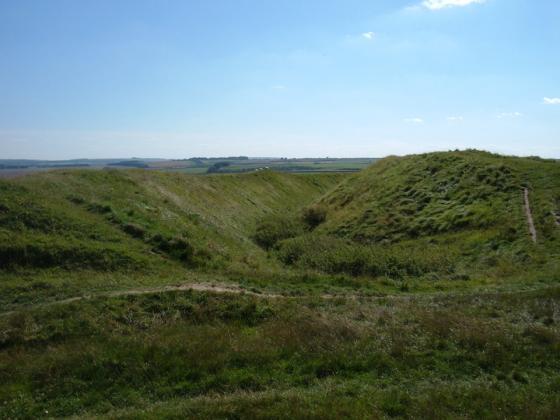G. vii. a.
This square mile contains a stone circle, of considerable dimensions, though imperfect and formed of very small sarsens, but which I believe to have been in some way connected with Abury. Though it appears to have been mentioned by Stukeley one hundred and forty years ago, it had been long since buried, and completely forgotten till I was fortunate enough to discover it by digging in the year 1877.
I was led to the discovery by the suspicious look of certain stones, which, though scattered in no regular form, appeared as if they might have once stood erect, in some sort of order, on the segment of a large circle. I had often stopped to examine them as I wandered over that part of the downs; till at last previous suspicions ripened into conviction, as closer observation revealed sundry other stones just showing above ground, and there also seemed to be faint indications of a trench, all pointing, with more or less accuracy, to the supposed circle.
Not to dwell upon the details of the investigation, which, however, were of singular interest to me, the result was that (with the permission of both owner and occupier of the land, and assisted by Mr. William Long) I probed the ground in every direction, and uncovered the turf wherever a stone was found : and on our first day’s work we unearthed no less than twenty-two sarsen stones, all forming part of the circle, and lying from two to twelve inches below the surface. These stones were all of small size, some of them very small,1 but that they were placed by the hand of man in the positions they now occupy, in many cases nearly touching one another, and that they formed part of a large circle or oblong, admits, I think, of no doubt. I say part of a circle, because, though the northern, southern, and eastern segments are tolerably well defined, I could find scarcely a single stone on what should be the western segment to complete the circle. That the area thus enclosed is not insignificant will appear from the diameter (in length, or from north to south, 261 feet; and in breadth, or from east to west, 216 feet). Again, its position (due south of Silbury, and within full view of it, as well as of the Sanctuary on Overton Hill, and with Abury immediately behind Silbury, due north of it, from which also Silbury is equidistant) seems to intimate that it may have had some connection with the great temple.
W. Stukeley mentions, in the following passage from page 46 of Abury Described, “Upon the heath south of Silbury Hill was a very large oblong work like a long barrow, made only of stones pitch’d in the ground; no tumulus. Mr. Smith before-mentioned told me his cousin took the stones away [then] fourteen years ago, to make mere stones withal. I take it to have been an Archdruid’s, tho’ humble, yet magnificent: being 350 feet or 200 cubits long.”
Sir R. Hoare, who, it is evident, did not know its exact locality, merely remarks on page 96 of Ancient Wilts, North, that ” Stukeley mentions on a heath south of Silbury Hill, a large oblong work made only of stones pitched on end, but no sepulchral mound.”
Subsequently, however, in speaking of ” Religious Circles,” he says on page 108: “In many parts of our county we find circles enclosed by a slight vallum of earth, some having an entrance, and others none: they are usually placed on elevated ground, and in commanding situations. On exploring their area, we dig up black earth with the fragments of bones, probably the victims of sacrifice: they are generally found to be placed near to some British settlement, and in some instances I have found them within it, and forming a part thereof, as in modern days the Church is considered as a feature of the village, and a necessary appendage. Such is the case within the lines of the British works on Huish Hill, in North Wilts.”
So says Sir R. Hoare, though I must confess that I cannot ascertain the existence of any similar circle of diminutive stones either on Huish Hill, or anywhere else in North Wilts: though in Denmark such circles are not uncommon, and often of very trifling dimensions, with a diameter of 20 to 25 or 30 feet, and oftentimes diverging into other (frequently strange and irregular) shapes, and composed of small stones. There is an admirable exemplification of such diminutive stone circles, oblongs, triangles, and other forms, in the Plan of the Promontory of Hjorte-hammers. But what may have been the intention of these Danish circles and squares and triangles, abundant though they are on the coast of Jutland, I do not think the Danish antiquaries have ever determined.
Nor were the members of the Wiltshire Archaeological Society, with Sir John Lubbock at their head, who visited this stone circle south of Silbury in 1879, able to form any opinion as to its object; nor could the able antiquaries of the British Archaeological Association, who visited it in 1880, give any decided verdict on the point: indeed they, not unnaturally, shrank from committing themselves by any off-hand expression of opinion: though all appeared to consider it as of great interest, and as worthy of very careful examination, more especially in its supposed connection with Abury and other allied relics of antiquity near.






















































































































































